MINERVA platform: User’s manual#
User view refers to the visualization and functionalities accessed by users of the content hosted by your MINERVA instance.
You can also see the summary of this page in the MINERVA Quick Reference Guide.
MAIN VIEW#
The main view of the MINERVA platform is summarized in the figure below.
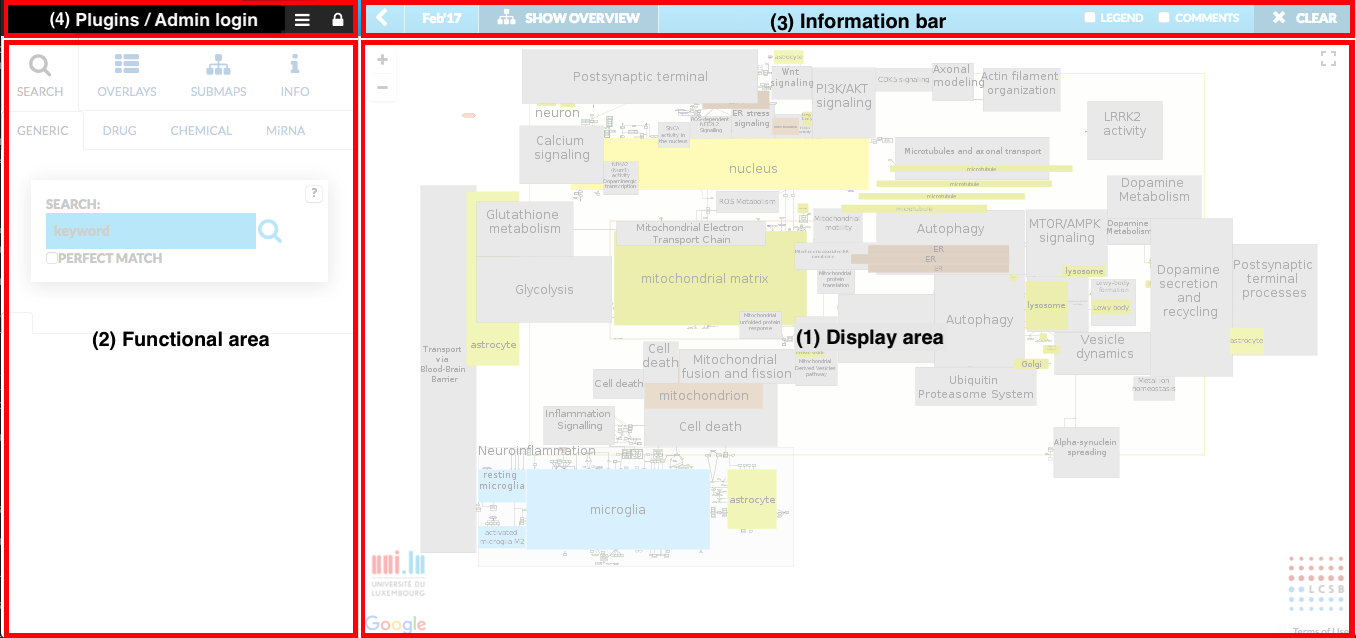 {:width=“900px”}
{:width=“900px”}
Main components of this view are:
(1) Display area where the contents of the projects are visualized. (2) Functional area allowing for advanced interaction with explored content. (3) Information bar containing additional overlay functions. (4) Plugins / Admin login allowing administrator on login and user on upload own plugin. Note: To login as a user go to Overlays or Info tab.
Accessing the project#
Your instance of MINERVA platform can host many projects, which are uploaded via the administrator view (check Administrator’s manual - Add project). The projects are accessed by a provided, dedicated web address.
Exploring the display area#
The content is visualized using Google Maps API or Open Layers Library (depending on user preferences). It allows similar pan and zoom functionalities. The content is interactive, the user can click on an element or interaction to examine additional details displayed in the left panel (functional area).
The content is by default displayed in a semantic zoom mode, where compartments and areas in the submitted file cover underlying elements on higher levels of zoom. This view is generated procedurally, directly from the uploaded content - the layouts of the CellDesigner file. MINERVA platform calculates coverage of bigger areas by smaller, and assigns them to appropriate zoom levels. For more details see Content curation. You can turn off the semantic zoom view by going to the Overlays tab in the left panel (functional area), and changing the view to Network.
Basic exploration tools#
Right-click in the display area invokes a contextual menu (see below), which allows to annotate, select and download displayed area and visualize proteins’ structure.
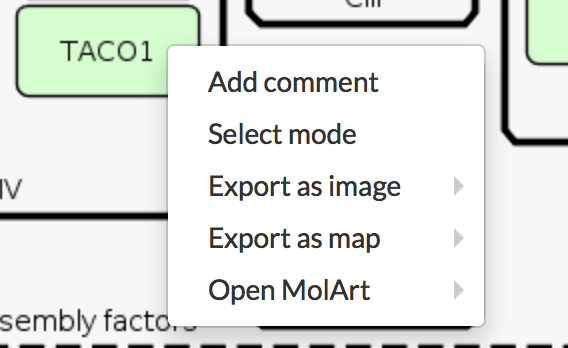 {:width=“400px”}
{:width=“400px”}
Add comment#
This functionality allows to annotate contents in the display area. Clicking on Add comment invokes a form that can be filled out by the user and sent to the administrators of the project (see below left). Type field is a drop-down menu, listing elements nearby to the click location. This allows to choose and attach the comment to a particular element or interaction (see below middle). If particular type is selected, its name is displayed (see below right). The field Pinned controls, whether the comment will be visible in the map.
 {:width=“900px”}
{:width=“900px”}
After sending, if the Pinned box was ticked, the comment bubble becomes visible in the display area (see below left). Note that the checkbox Comments located in Information bar must be ticked to make comments visible at all.
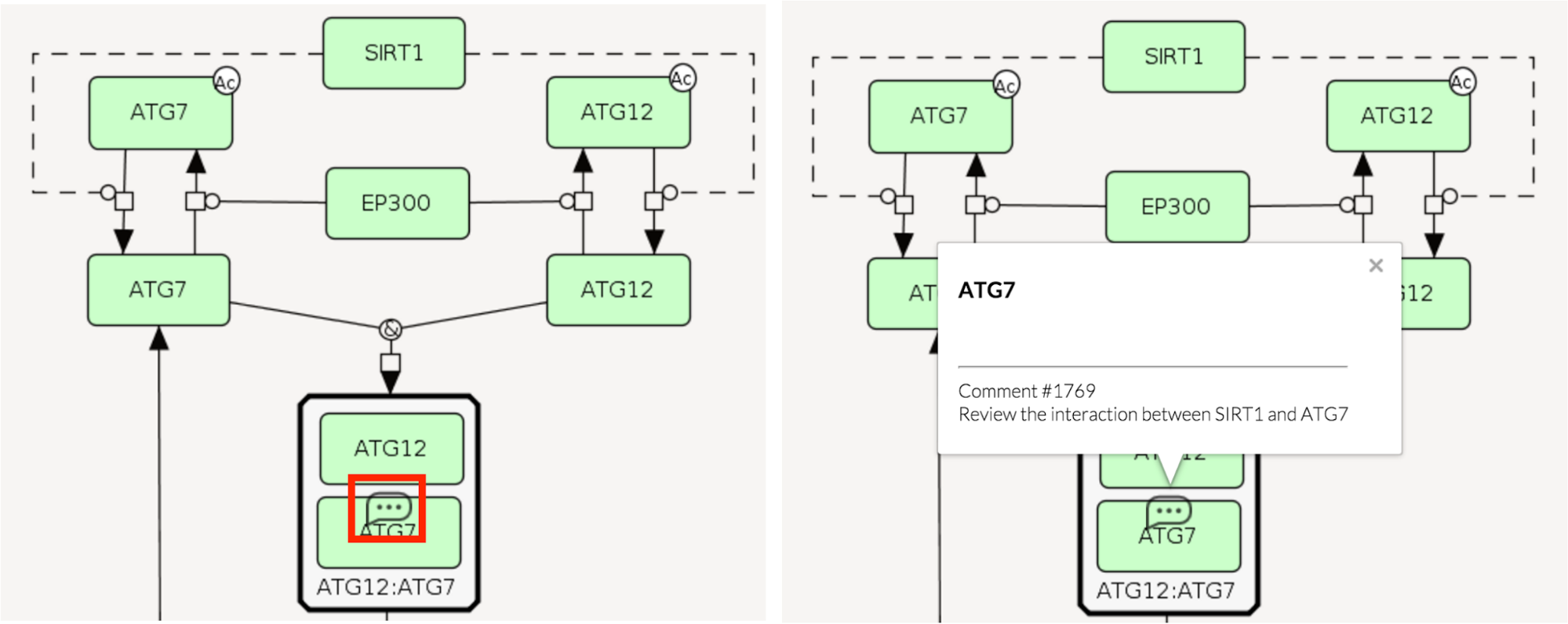 {:width=“900px”}
{:width=“900px”}
Clicking on the comment bubble displays annotated element and the text of the comment (see above right). Name and email are not disclosed, they will be accessible only to project and platform administrators (see Administrator’s manual - Comments).
Select mode#
Clicking the Select mode enables the functionality supported by Google Maps API and Open Layers Library. It allows to select an arbitrary shape in the display area. Note: the end point of the polygon you draw must be the same as the start point. Right click on the selected area allows on remove the selection or download it in various formats, either as a map or an image (see below).
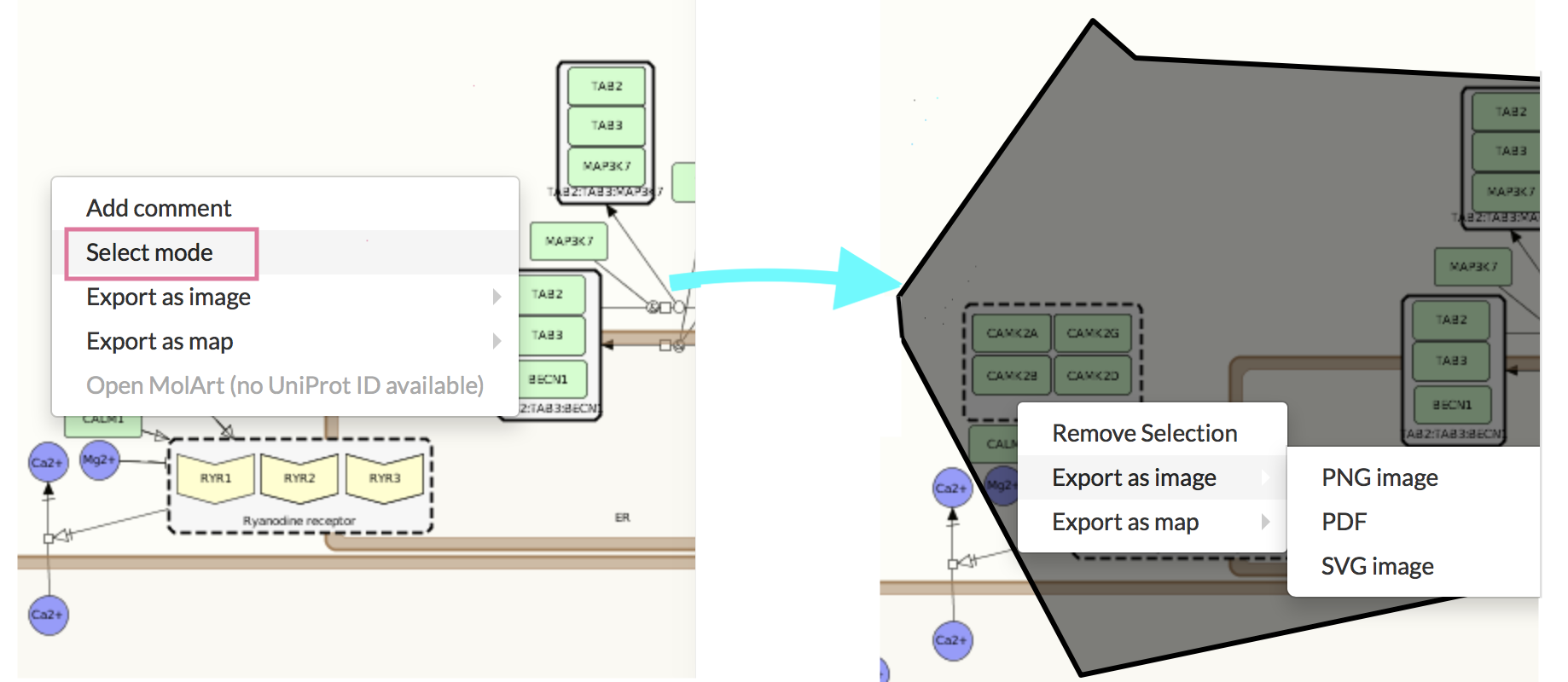 {:width=“900px”}
{:width=“900px”}
Export as image produces a rectangular image containing the selection. Export to vector and raster graphics is supported, allowing to modify and enhance the downloaded image.
Export as map produces a file acceptable by either CellDesigner, pure SBGN or SBML editors, containing the editable fragment of the selected display area. Importantly, in the case of CellDesigner export, all additional annotations provided by MINERVA platform are downloaded as well.
Export as image#
This option creates an image of the part of map on your display area. Export to vector graphics is supported, allowing to modify and enhance the downloaded image.
Export as map#
This option allows to produces a file acceptable by either CellDesigner, pure SBGN or SBML editors containing the editable fragment of the selected display area. Importantly, in the case of CellDesigner export, all additional annotations provided by MINERVA platform are downloaded as well.
Open MolArt#
This option is active only for protein annotated with UniProt ID (see image below). MolArt (MOLeculAR structure annoTator) is a JavaScript tool and library. It assists users in the visualization of sequence-related annotations over available experimental or predicted structures (click here for MolArt documentation).
 {:width=“900px”}
{:width=“900px”}
MolArt displays in the left panel the molecule’s sequence, relevant annotations (including variation data) and list of available structures (either experimental or predicted) for given molecule. The right panel shows selected 3D structure over which any of the sequence annotations can be color-overlaid. See image below:
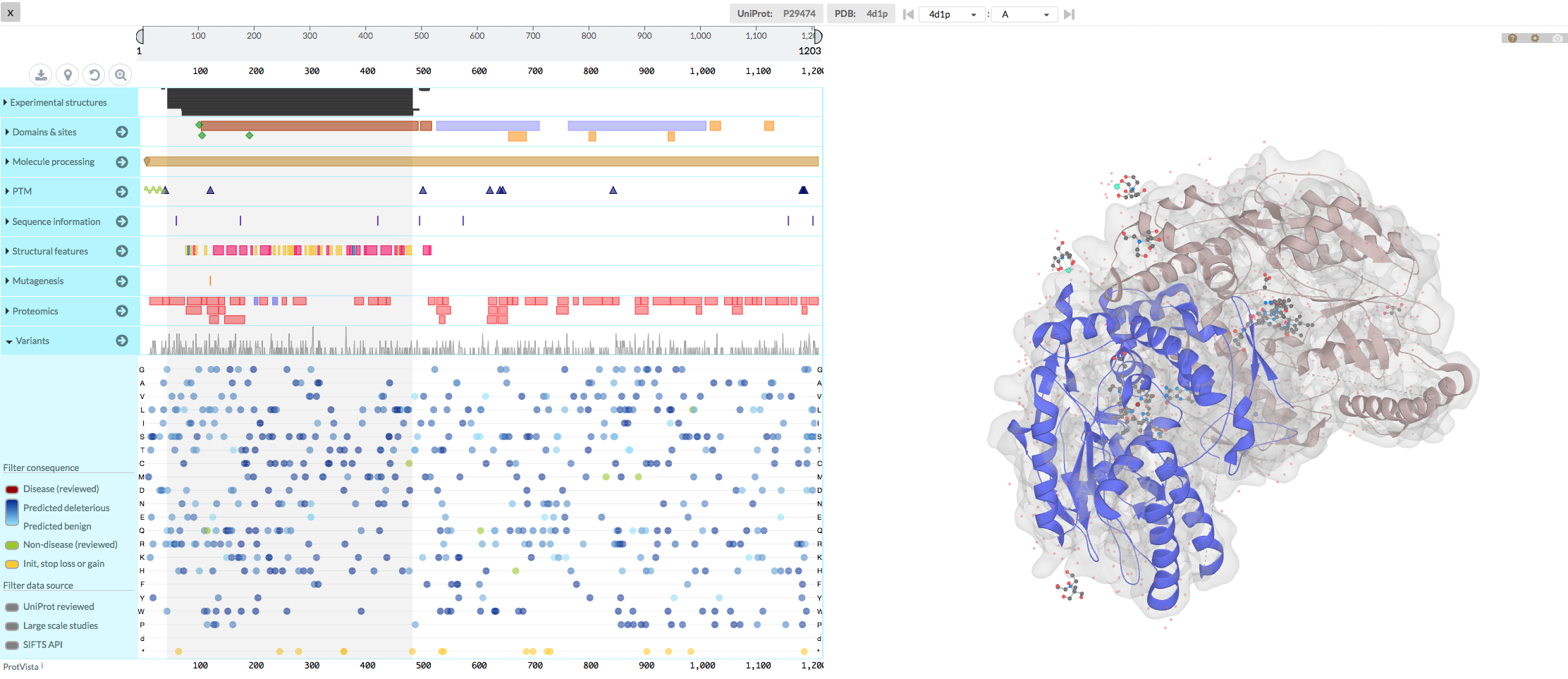 {:width=“900px”}
{:width=“900px”}
Content curation#
MINERVA framework handles SBGN-compliant format and SBML format - these two are externally curated content which MINERVA relies on. In case of SBML format it is essential to modify the file before the upload to MINERVA.
SBGN-compliant format#
MINERVA handles SBGN-compliant format produced either by CellDesigner (click) or SBGN editors like SBGN-ED (click). Moreover, a number of additional functionalities of MINERVA operates on metadata that can be provided in the SBGN-compliant file itself. These are the following:
Processing of existing annotations: annotations to elements or interactions embedded within CellDesigner file (MIRIAM > Add relation) are automatically parsed and processed. They can be used to extensively annotate elements (see Administrator’s manual - Configure automatic annotation) and they can be verified by MINERVA platform against a set of predefined content-governing rules (see Administrator’s manual - Configure automatic verification).
Procedural generation of semantic zoom: information on complexes and overlaying compartments is extracted from SBGN-compliant files to generate Pathways and compartments view, where on the high level of zoom bigger compartments overlay smaller ones, and on the middle levels of zoom contents of complexes are masked. Moreover, in CellDesigner, TextArea elements can be used to draw named rectangles covering functionally important areas. These will be incorporated into the generation of the semantic zoom as well. For this, you will need to create an additional area in CellDesigner by:
- clicking Edit > Add layer
- enabling Layer toolbox by checking View > Change toolbar visible > Layer
- drawing TextArea objects using a corresponding button
Custom semantic zooming (CSZ) allows user to define the semantic zoom levels for any element or compartment. A particular (CSZ) levels are defined in the CellDesigner file, in the field NOTE > Edit Notes of specific element/compartment. To describe CSZ, input in that field the below terms and specify the zoom level value (0, 1, 2…):
- SemanticZoomLevelVisibility: zoom_level is used to set up the visibility level for the element or the compartment (e.g. SemanticZoomLevelVisibility: 2 - meaning that on zoom level 2 the element would be displayed on the map)
- TransparencyZoomLevelVisibility: zoom_level to set up the transparency of the compartment (e.g. TransparencyZoomLevelVisibility: 1 - meaning that on zoom level 1 the content of that particular compartment would be revealed of the masking)
The CSZ can be set up for any project during its upload to MINERVA, see: Administrator’s manual - Add new project.
Cross-platform SBGN translation: CellDesigner files can be uploaded to be displayed in pure SBGN notation (see Administrator’s manual - Fields of the Add project window), and SBGN-displayed content can be downloaded as a pure SBGN file.
For explanation and examples on content curation and annotation, see Example 01 - CellDesigner file upload and annotation.
SBML format#
SBML file contains text information about elements, reactions and annotations. MINERVA takes annotations from SBML file as the inputs and transforms them to element/interaction annotations which can be displayed in the map. Use of SBOTerms is necessary to determine the type of elements/interactions. Moreover, SBOTerms must be inputted into the SBML file by user manually. Without updating SBML file on SBOTerms, all elements are displayed on map as small molecules and all reactions are represented by state transitions. See here the list of CellDesigner types matching SBOTerms.
For explanation on modifying SBML file, see Example 02 - SBML file modifications.
FUNCTIONAL AREA#
Functional area (the panel to the left from the display area) displays additional information about selected elements and interactions, allows to query the content, generate custom overlays and browse submaps.
Search tab#
Search tab allows to search for particular elements or interactions in the displayed map. Also, under this tab, the panel displays detailed information on selected elements or interactions, such as: element’s compartment and full name, symbols, annotations and their source (automatic or manual by curator), see below:
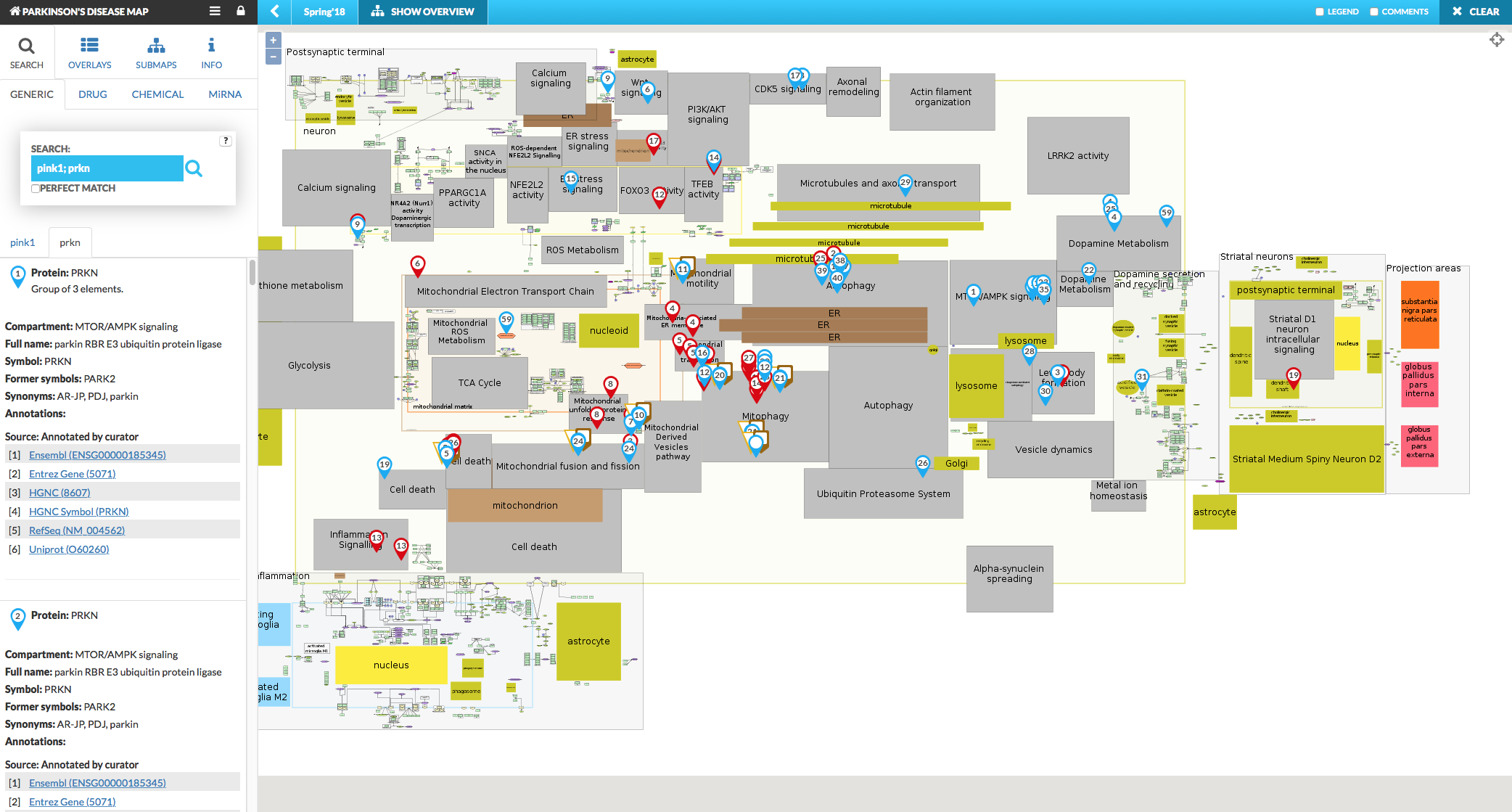 {:width=“900px”}
{:width=“900px”}
There are four subtabs available in the Search tab, offering different scopes:
- GENERIC for regular search
- DRUG for drug target search
- CHEMICAL for chemical target search
- MiRNA for miRNA target search
GENERIC#
The generic scope works as follows:
- Search field: Type your search query here, separating multiple elements with a semicolon ‘;’. Searches for separate terms will be visible in separate tabs. Search will look for similar names and synonyms of elements in the map. You can also search for an identifier of an interaction. (It is described by a number, to be found on the left panel after choosing a particular reaction you are interested in.) To do this, you need to add reaction: prefix to the searched identifier, e.g. for a reaction with and id “re944” you will search for a term “reaction: re944” (see below).
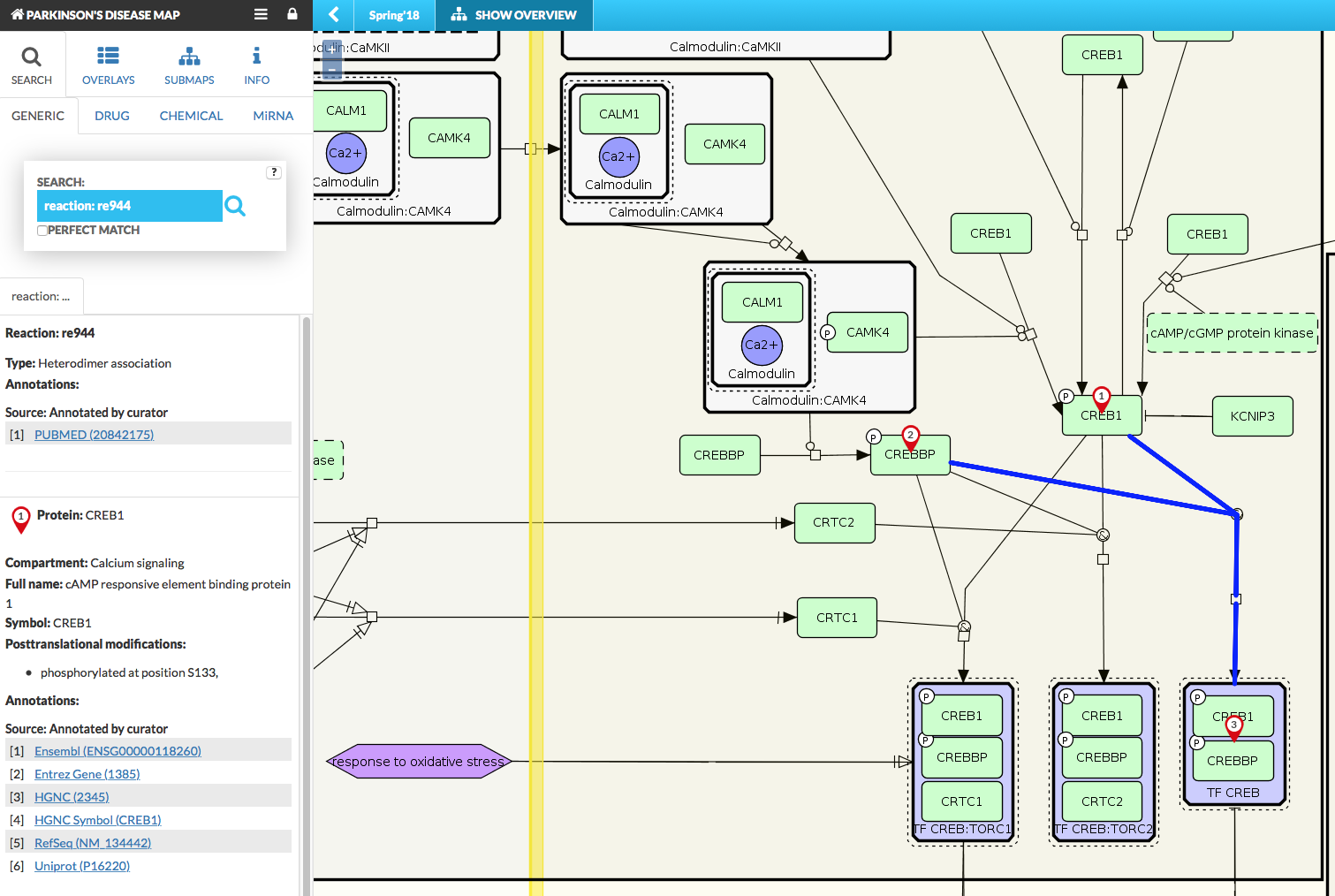 {:width=“900px”}
{:width=“900px”}
The reaction results are supported with information about reaction kinetics. It is available after clicking on chosen reaction in the display area.
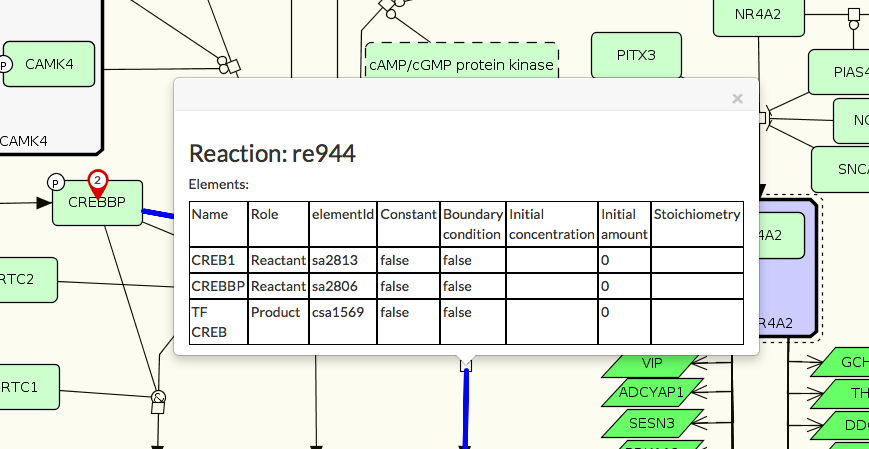 {:width=“600px”}
{:width=“600px”}
The search pins indicate hits in the display area. Similar search results are merged (marked with the same number) and the left panel contains information about size of that group of x elements. If search pin happened to be blank (no number), it would mean that aggregated search results exceed 100. Moreover, for multiple elements search, the results have different color and shape icons (see image below) which are clickable and show information in popup window. In case of searching for different targets (e.g. generic target and drug target) the overlaying results are highlighted with different icon. The same icon on main map informs that searching results hit in the submap. See more in Submaps tab.
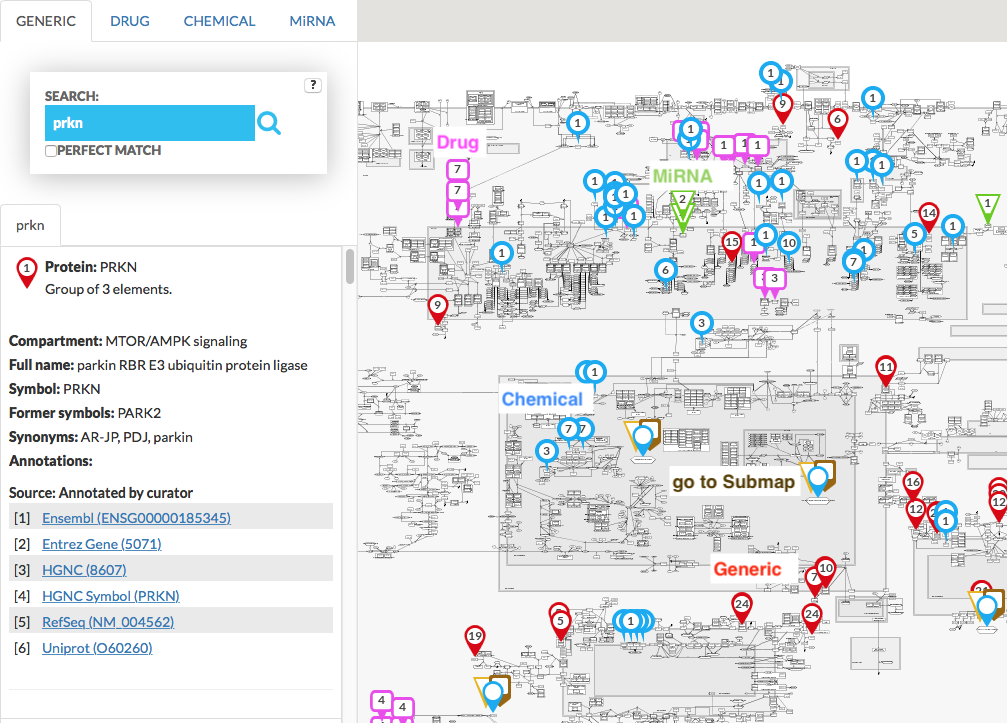 {:width=“900px”}
{:width=“900px”}
- Perfect match tick box: If this box is ticked, terms with an exact match to the query will be returned. In the case of large networks or broad queries the search results may be capped to ensure the performance of the system. The limit of displaying search results can be configured via the Admin view (see Administrator’s manual - Configuration).
Direct link to the elements in the display area is possible, as the search query can be provided within the web address of the displayed project. An address has to be manually constructed, directly into web browser, as below:
your.webserver.address/?search='search query'is a link executing the search for a given search query in the default project of your MINERVA instance. For example, an address
your.webserver.address/?search=reaction:xyz123will directly point to an interaction with id xyz123. Referring to a given project on your MINERVA instance requires additionally to pass the project identifier in the address, as shown below. Identifiers of projects are accessible using the Admin view.
your.webserver.address/?id='project id'&search='search query'DRUG (target)#
The Drug scope works as follows. Drug subtab under the the Search tab allows to look for known drugs or their brand names and display their targets in the map. Targets will be marked by pins in the display area. Please, note that they have specific shape, different than the results of other search scopes.
- Search field: type your search query here, separating multiple drug names or their brand names with a semicolon ‘;’. DrugBank (click) and ChEMBL (click) will be queried for known targets to be displayed in the map.
- Drug description, synonyms and all known targets will be displayed in the left panel.
CHEMICAL (target)#
The Chemical scope works as follows. Chemical subtab under the the Search tab allows to look for known chemicals or their synonyms and display their targets in the map. Targets will be marked by pins in the display area. Please, note that they have specific shape, different than the results of other search scopes.
- Search field: type your search query here, separating multiple chemical names or their synonyms with a semicolon ‘;’. Clinical Toxicogenomics Database (click) will be queried for known targets to be displayed in the map.
- Drug description, synonyms and all known targets will be displayed in the left panel.
MiRNA (target)#
The microRNA scope works as follows. MiRNA subtab under the the Search tab allows to look for miRNAs and display their targets in the map. Targets will be marked by pins in the display area. Please, note that they have specific shape, different than the results of other search scopes.
- Search field: type your search query here, separating multiple miRNAs with a semicolon ‘;’. miRTarBase (click) will be queried for known targets to be displayed in the map. Use only mature sequence IDs according to miRBase (click) (e.g. hsa-miR-125a-3p)
- known targets will be displayed in the left panel.
Overlays tab#
Overlays tab allows to display or generate custom coloring of elements and interactions in the map. It is composed of two sections - general overlays and user-provided overlays (which becomes visible upon login).
- View column allows to change the viewing mode and display default multiple overlays:
- Viewing mode is changed by clicking on the magnifying glass icon, allows to switch between:
- Pathways and compartments (hierarchically masked content)
- Network (only colored network structure shown)
- Empty (only network structure, no coloring, recommended for data display)
- Display multiple overlays (tick chosen boxes) - choosing that option automatically turns the viewing mode to Empty to emphasize the overlay’s colors.
- Viewing mode is changed by clicking on the magnifying glass icon, allows to switch between:
- Data column contains buttons, where applicable, allowing to download the dataset used to generate the overlay.
Overlays provide additional information about elements and interactions. Hover over the overlay name/view/data to display a short description of the dataset, if provided on upload. Overlays are also visible in the popup window, displayed after clicking on the element’s pin, showing the value and the sign marked on the horizontal color bars. Moreover, the popup contains information about Interacting drugs, chemicals and MicroRNA with selected element, available after ticking check box Show all.
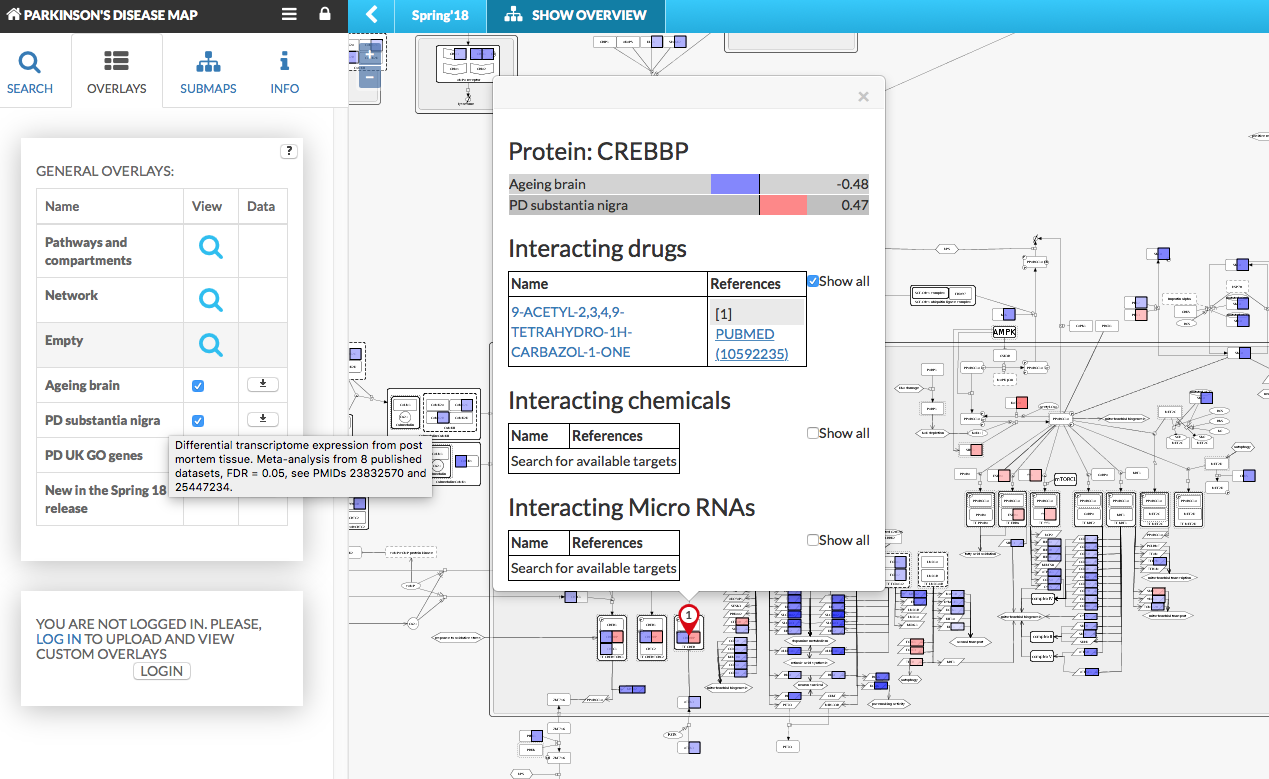 {:width=“900px”}
{:width=“900px”}
In the figure above:
- General overlays are overlays accessible for every user viewing the content
- User-provided overlays menu becomes available upon login (see below)
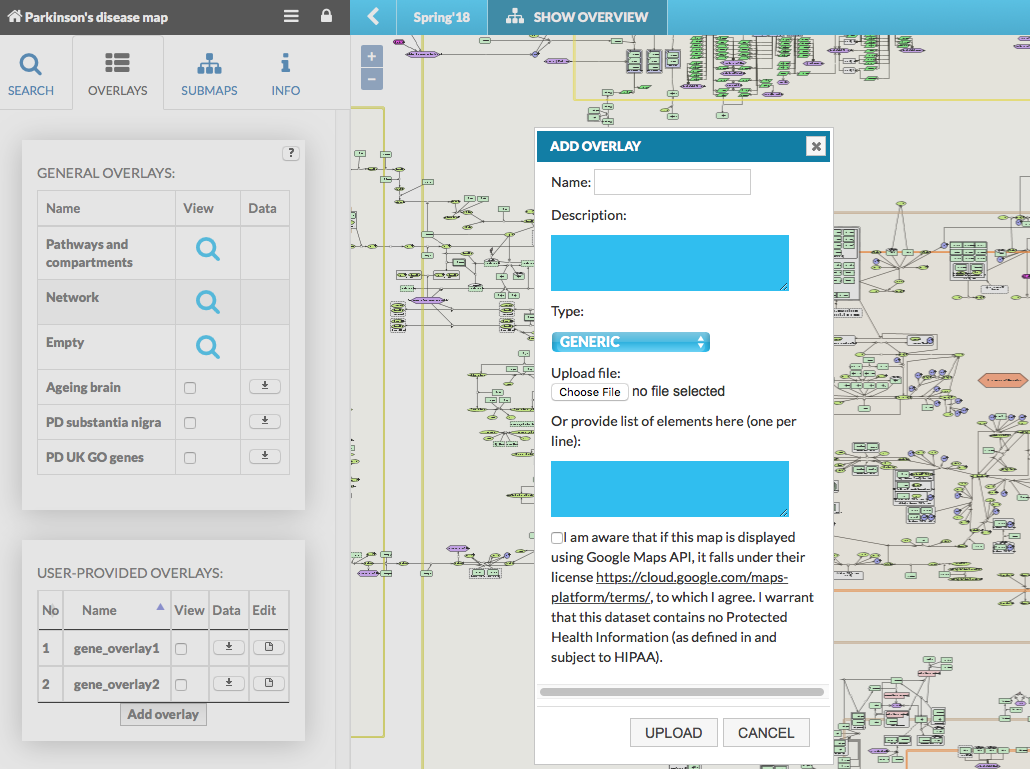 {:width=“900px”}
{:width=“900px”}
User-provided overlays table contains overlays uploaded by users. Available overlays can be reordered by name or number. Hover over any of them display short description, if one was provided on upload. There are two types of overlays the user can provide: generic and genetic variant. Generic overlay displays a coloring of the map data set of indicated molecules (e.g. differentially expressed genes), genetic variant overlay displays a coloring for the genes where the variants are present. It also enables the genome browser popup, displaying the position of a variant in the sequence of the corresponding gene. To upload and correctly display the genomics information your instance must contain reference genomes, uploaded by admin. Also, the Organism type (e.g. 9606) must be provided for the project, and reference genomes uploaded on MINERVA instance must include its type.
The list of user-provided overlays contains columns (image above):
No number of the overlay
Name of the overlay
View column with boxes enabling switching between User-provided overlays
Data column with buttons allowing the user to download the dataset used to generate the overlay. The users have access only to their respective datasets.
Edit column with buttons allowing the user to edit the description to the uploaded datasets
Add overlay button invoking the dialog window with the following components
- Name field for the new overlay
- Description of the dataset
- Type - field depends on the header of uploaded file - TYPE field. This happens because genetic variant overlays need to have a specific header field. Please, refer to Upload user-provided overlay data for more details.
- Upload file - Choose file button to select a file with overlay data
- List of elements field - instead of providing an overlay file, the user can provide a list of named elements to highlight in the map (e.g. list of genes). If providing generic overlay, choose from TYPE dropdown list GENERIC; if providing genetic variant overlay choose GENETIC_VARIANT. Check how to create a list of elements in Upload user-provided overlay data.
- Google Maps API terms of use checkbox
- Upload button to generate the user-define
The user-provided overlays are displayed identically as default general overlays. The genomics variant overlays additionally contain the genome browser in the popup window, see below image:
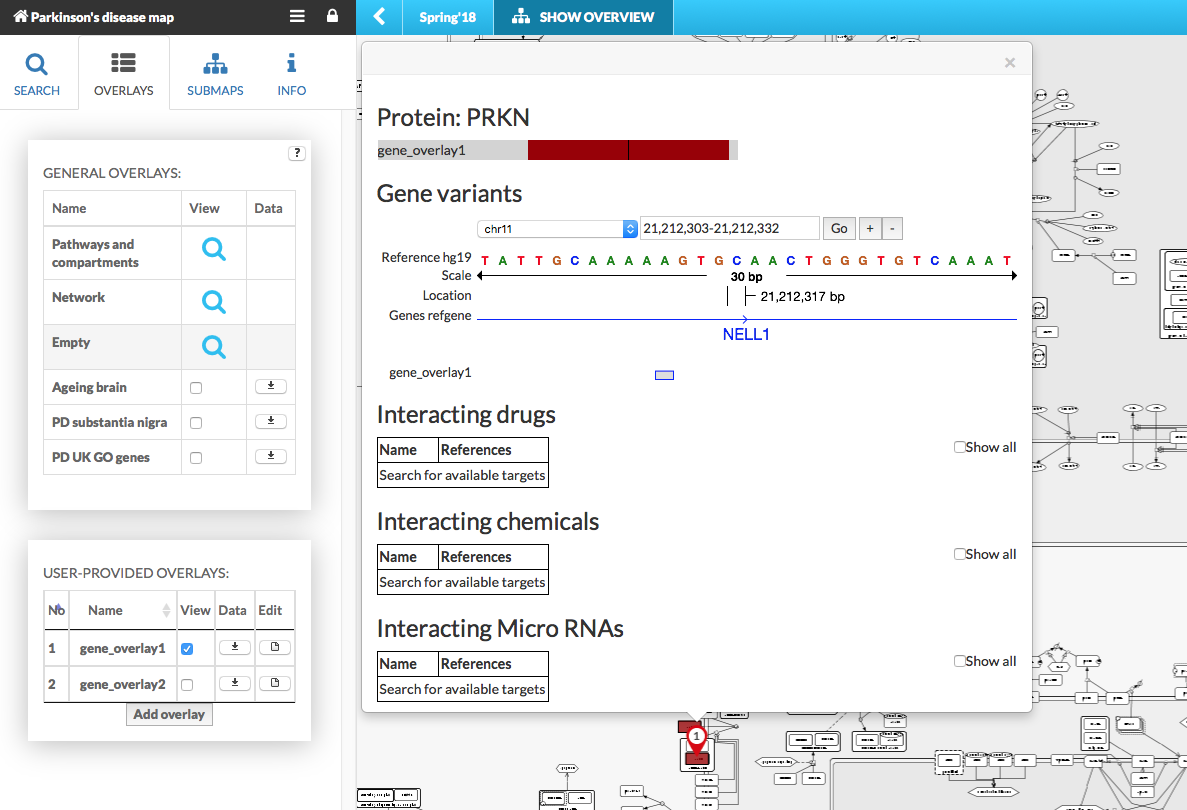 {:width=“900px”}
{:width=“900px”}
The genome browser allows to view the position of a variant in the sequence of the corresponding gene. In Gene variants section (see above) user can choose the location in chromosome, zoom the scale in/out by clicking on +/- buttons and swipe the base pairs axis. The popup window contain following:
- Reference genome - contains reference genomes uploaded into the instance by admin (e.g. hg19, hg38)
- Scale - the scope of base pairs displayed, changed by +/- buttons
- Location - indicates current position in genome
- Genes ref - display the reference genes locus provided to the instance by admin, see more in Administrator’s manual - Add new genomes
- User-provided overlay - display the variants from uploaded file
Upload user-provided overlay data#
For examples of basic and advanced data upload, see Example 03 - Custom data upload by registered users. The description of the formats follows below.
Basic format The basic format of file containing the uploaded data is two-column, tab-separated text file, with the columns Name and Value.
- Name column contains the names of elements to be colored
- Value column contains the values normalized to [-1,1] range.
Basic format will match names of the elements provided in the Name column among the names of elements in a given network and for the matching ones will assign them colors: blue for negative values, red for positive values, with the saturation proportional to the value. The color range for the data upload is customizable in the admin panel.
Advanced format The advanced format allows for by identifier matching, custom color assignment and coloring of interactions. Advanced format foresees two parts of the uploaded dataset - the header and the body.
Header lines have to start with ‘#’. It can contain the following elements:
- Version
# VERSION=xyz- a version of this custom overlay - Name
# NAME=xyz- a name that will be automatically assigned upon upload - Description
# DESCRIPTION=xyz- a description that will be automatically assigned upon upload
Body is a table with a following set of allowed columns:
- Name, Value - same as in basic overlay
- Compartment - name of a compartment in which coloring should take place Warning! Coloring compartments works ONLY for separate (not nested) compartments. Setting a color for elements in a compartment that encloses other compartments sets the color in the nested compartments as well.
- ChEBI - ChEBI identifiers of elements to be colored
- Entrez gene - Entrez identifiers of elements to be colored
- Gene ontology - Gene Ontology identifiers of elements to be colored
- Ensembl - Ensembl identifiers of elements to be colored
- HGNC symbol - HGNC symbols of elements to be colored
- UniProt - UniProt identifiers of elements to be colored
- ReactionIdentifier - ID of interaction to be colored (interactions coloring only)
- LineWidth - lineWidth of the colored interaction (interactions coloring only)
- Color - color of the colored element.
The dataset for upload may be integrated and sparse, i.e. a document may contain all columns at once, and, where irrelevant, their content may be left blank. In other words, you can color interactions and elements in the same dataset, leaving blank fields in ReactionIdentifier and LineWidth for elements, and leaving blank fields in Name for interactions.
Genetic variant format It is a particular type of advanced format, it contains the header and the body, see below:
- Type -
#TYPE=GENETIC_VARIANT - Genome type -
#GENOME_TYPE=UCSC- type of reference genome being used (e.g. UCSC) - Genome version -
#GENOME_VERSION=xyz- version of reference genome being used (e.g. hg19)
The body is a table with a following set of allowed columns:
- Position - the location of the variant in the genome
- Original_DNA - the reference DNA
- Alternative_DNA - the variant of the DNA
- Name of the gene with the variant
- Contig number of the chromosome
- Allele_frequency - relative frequency of this variant; it will be visualized by the height of the bar in the genome browser popup. See genetic variant overlay in Example 03.
Important note about adding overlay The overlay can be uploaded by pressing Upload or by pasting data into List of elements field. In case user uploads file, it must contain the header and the body. After choosing file, the dropdown list TYPE switches automatically between GENERIC/GENETIC_VARIANT as Minerva recognizes file’s header. If using filed List of elements, the header and the body must be provided in the list too. If providing generic overlay, choose from TYPE dropdown list GENERIC; if providing genetic variant overlay choose GENETIC_VARIANT. See more in Example 03 - Custom data upload by registered users.
Procedure After choosing the dataset to upload, pressing Upload button will invoke a comment and upload the overlay file. You will be notified by email when your overlay is ready. The email will also contain the list of elements in your dataset not found in the map.
Important reminder:
- The number of available overlays is configured in the Administrator’s manual - Users.
- The number of available overlays is common for all projects hosted on your MINERVA instance. If a user is registered in a number of projects and uploads custom datasets in all of them, the global number of available custom overlays will be reduced with each uploaded overlay.
Submaps tab#
The Submaps tab summarizes all the submap networks uploaded together and linked to the main network of this project hosted by your MINERVA instance. See Administrator’s manual - Source file to learn how to upload the submaps together with the main file. The tab Submaps is visible in the left panel, only if the map contains any submap.
The Submaps tab contains the Name column, and the column with the buttons invoking corresponding submaps.
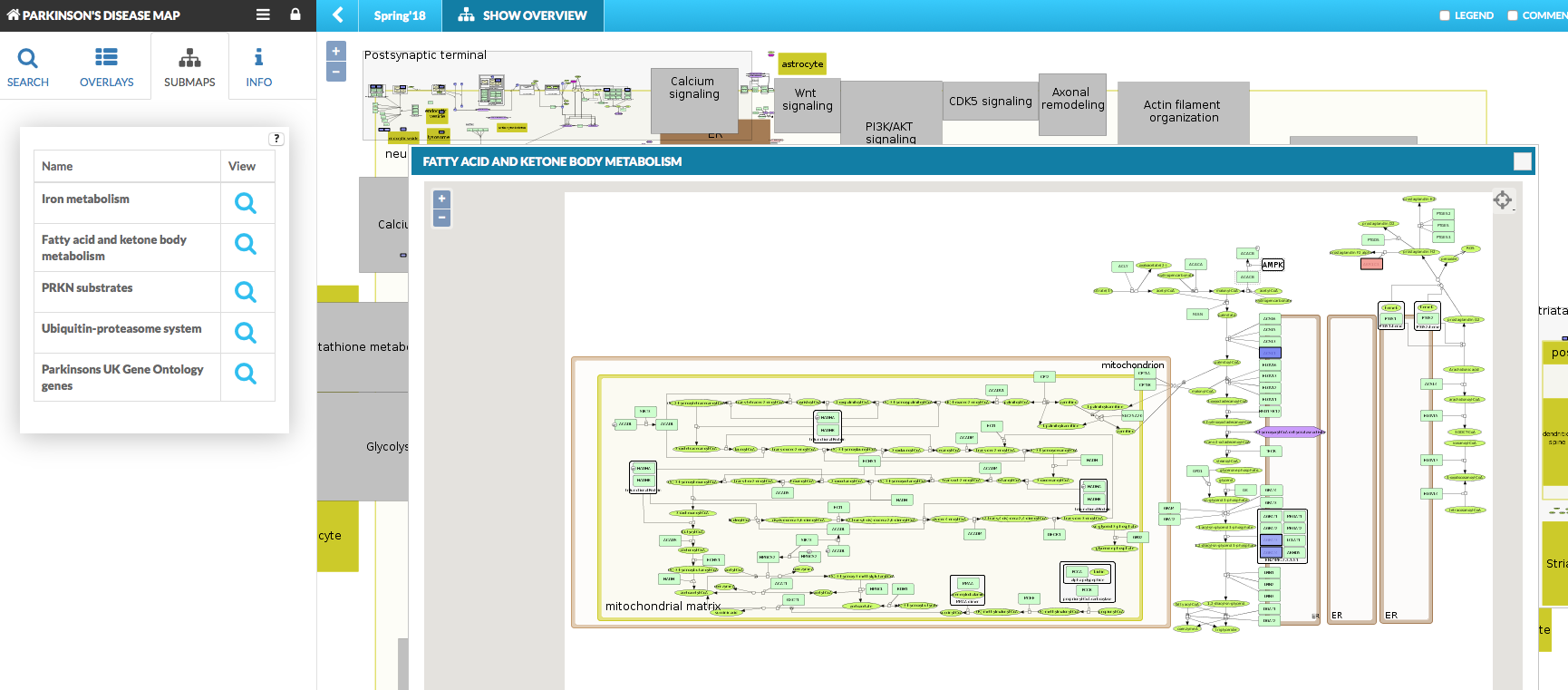 {:width=“900px”}
{:width=“900px”}
The submaps show as a pop-up window on top of the main map, and are synchronized with respect to search queries and displaying mapped experimental data. This means that search results and search target bubbles will be visible in the main map and the displayed submaps. Similarly, coloring for overlays are mirrored in the submaps. Moreover, on the main map there is icon informing that search results hit submap. See figures below:
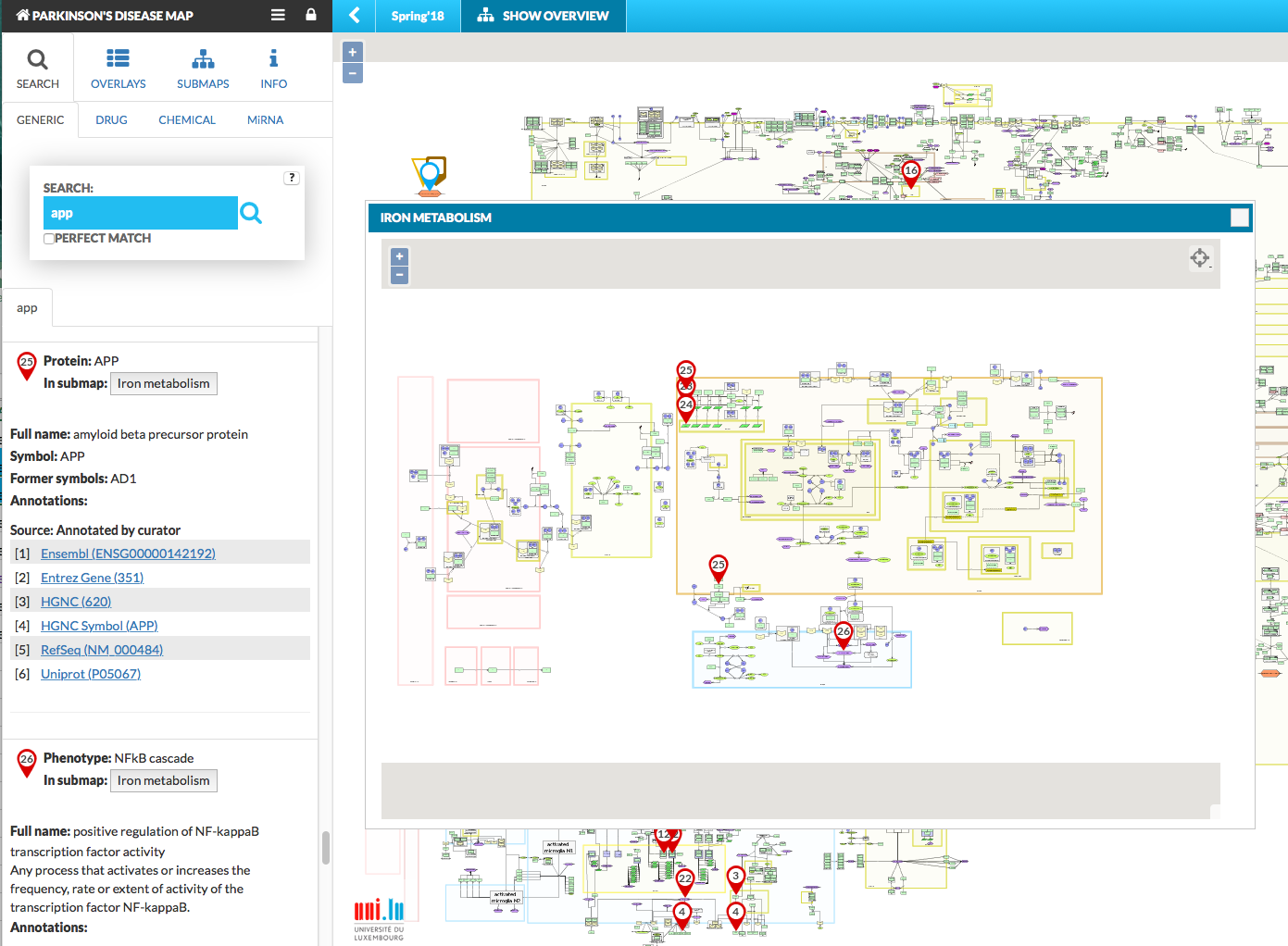 {:width=“900px”}
{:width=“900px”}
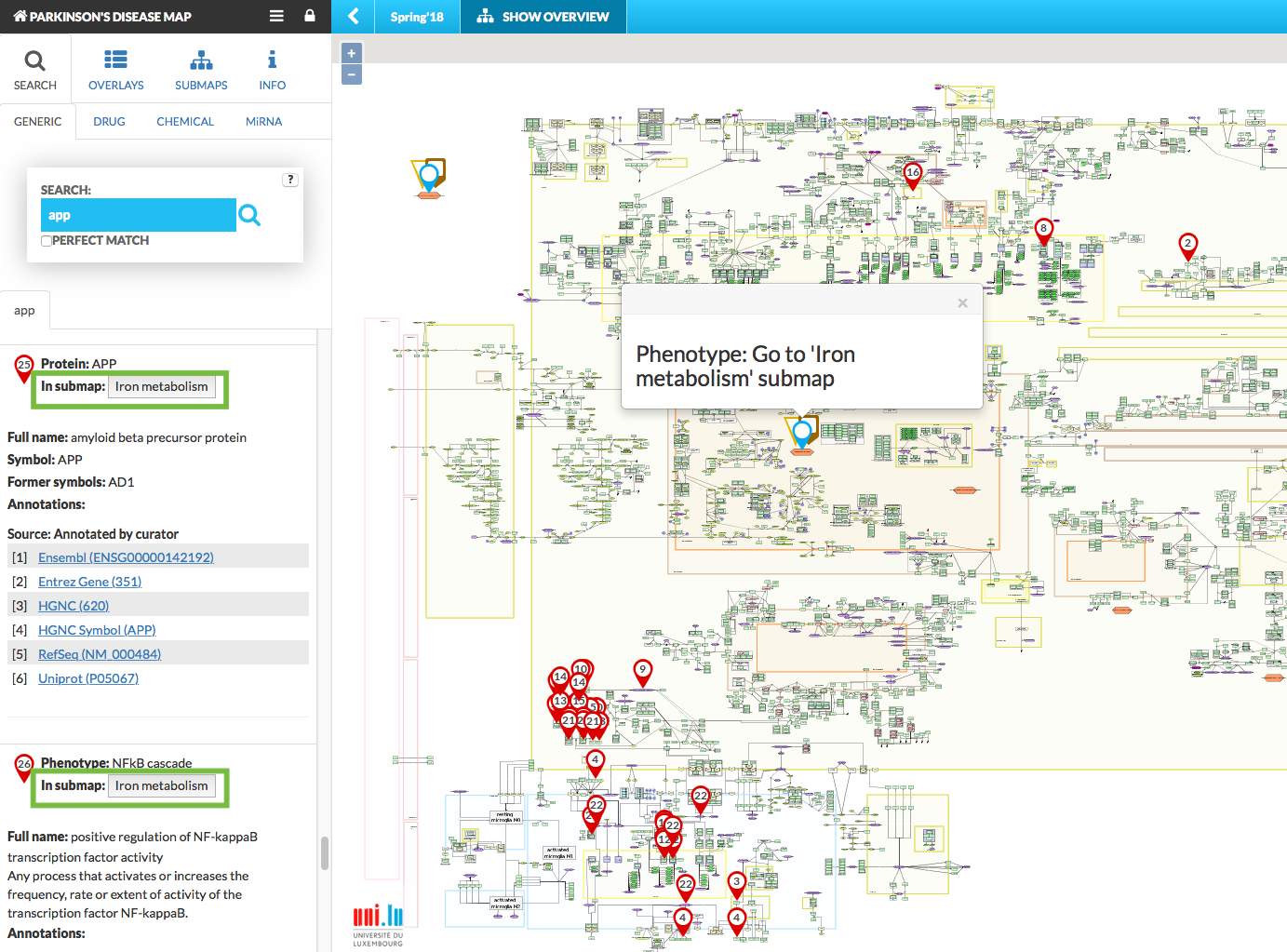 {:width=“900px”}
{:width=“900px”}
Info tab#
The Info tab has two components, displaying Project info and User data (for registered and logged in users).
Project info#
Displays name, version and description of the map.
The Data section features four links, allowing the user to:
- browse the publications supporting the map. The Publication list dialogue allows to search for articles by title or author names and contains links to interactions supported by particular articles.
- download the source files
- export the contents of the map (see below)
- open the manual
Export#
The Export page contains three tabs (Elements, Network and Graphics), allowing to download the hosted content in different formats.
- Elements tab allows to narrow down and download the list of elements in the hosted networks and export them to text file. Available filters include:
- Type - filters the exported elements by the SBGN-compliant type (e.g. Protein, RNA)
- Column - filters the contents of exported file by selecting particular columns. Available filters, among others, include:
- Id - identifier in the MINERVA system
- Name - name of the element
- Model - identifier of the (sub)network containing this element
- Type - SBGN type of element
- Complex - complex element containing this element
- Compartment - the smallest compartment/pathway containing the element
- Element external id - corresponding source file e.g. CellDesigner ID
- Annotations - filters the annotations of elements in the downloaded file; by default all annotation types are considered. Green highlighted fields are non empty annotation sources
- Included/excluded compartment/pathways - filters the elements by compartments/pathways they are in; by default all compartments are considered as “included”, none as “excluded”
- Network tab allows to narrow down and download the interactions in the hosted networks. Importantly, the exported network file is not a fixed-column table. As interactions are in fact hyperedges, each line may contain different number of reactants, products and identifiers. Available filters include:
- Type - filters the nodes of exported interactions by the SBGN-compliant type
- Column - filters the contents of exported file by selecting, which column should be included. Available filters, among others, include:
- Elements - contain information about reactants, products and reaction modifiers
- Element external id - reaction identifier corresponding source file e.g. CellDesigner ID
- Model - identifier of the (sub)network containing this element
- Type - type of reaction (e.g. state transition, transport)
- Annotations - filters the annotations of elements and interactions in the downloaded file; by default all annotation types are considered. Green highlighted fields are non empty annotation sources
- Included/excluded compartment/pathways - filters the elements by compartments they are in; by default all compartments are considered as “included”, none as “excluded”
- Graphics tab allows to download graphics of the (Sub)map in one of the Format: PNG image, PDF and SVG image
User data#
It allows a registered user to type in their login and password or request for an account from the administrators of this MINERVA instance. Platform administrators can register new users (see Administrator’s manual - General USERS) and configure Request an account functionality (see Administrator’s manual - Configuration)
After login, this panel displays information about the user. After the successful login the user gains the possibility to upload custom overlays (see Overlays).
INFORMATION BAR#
Information bar is the topmost part of the user view, containing the Show overview button, Comment and Legend checkboxes and Clear button. The Clear button clears all search results currently shown in the display area. The remaining functionalities are detailed below.
Show overview#
This button invokes a static image associated with the displayed content. It may be a graphics facilitating the understanding of the underlying network, or any other visual cue that the content curator decided to present. The initial image displayed with the Show overview button can be linked to:
- another static image to be displayed next
- a defined area in the displayed content
- a set of elements or interactions.
Detailed information on how to configure Show overview images display is provided in Administrator’s manual - Source file.
Comments#
If this checkbox is checked, the comments provided by users with Pinned option set to Yes will become visible in the display area (see also Section Add comment).
Legend#
If this checkbox is checked, the legend describing element and interaction types will be displayed.
PLUGINS#
Plugins allow for creating client-side custom visualizations, independent from the core functionalities of MINERVA. After clicking on the plugin icon (see image below) a popup window becomes available.
![]() {:width=“600px”}
{:width=“600px”}
In the URL field one needs to supply a URL to the plugin, written in JavaScript. To learn how to write your own plugins, visit the “Plugin starter kit” repository here
For example, you can use a link for an example plugin:
https://raw.githubusercontent.com/davidhoksza/minerva-plugins-starter-kit/master/dist/plugin.js
Afterwards, a plugin panel becomes available on the right (see image below). To close that panel, go to plugin icon and click Unload button.
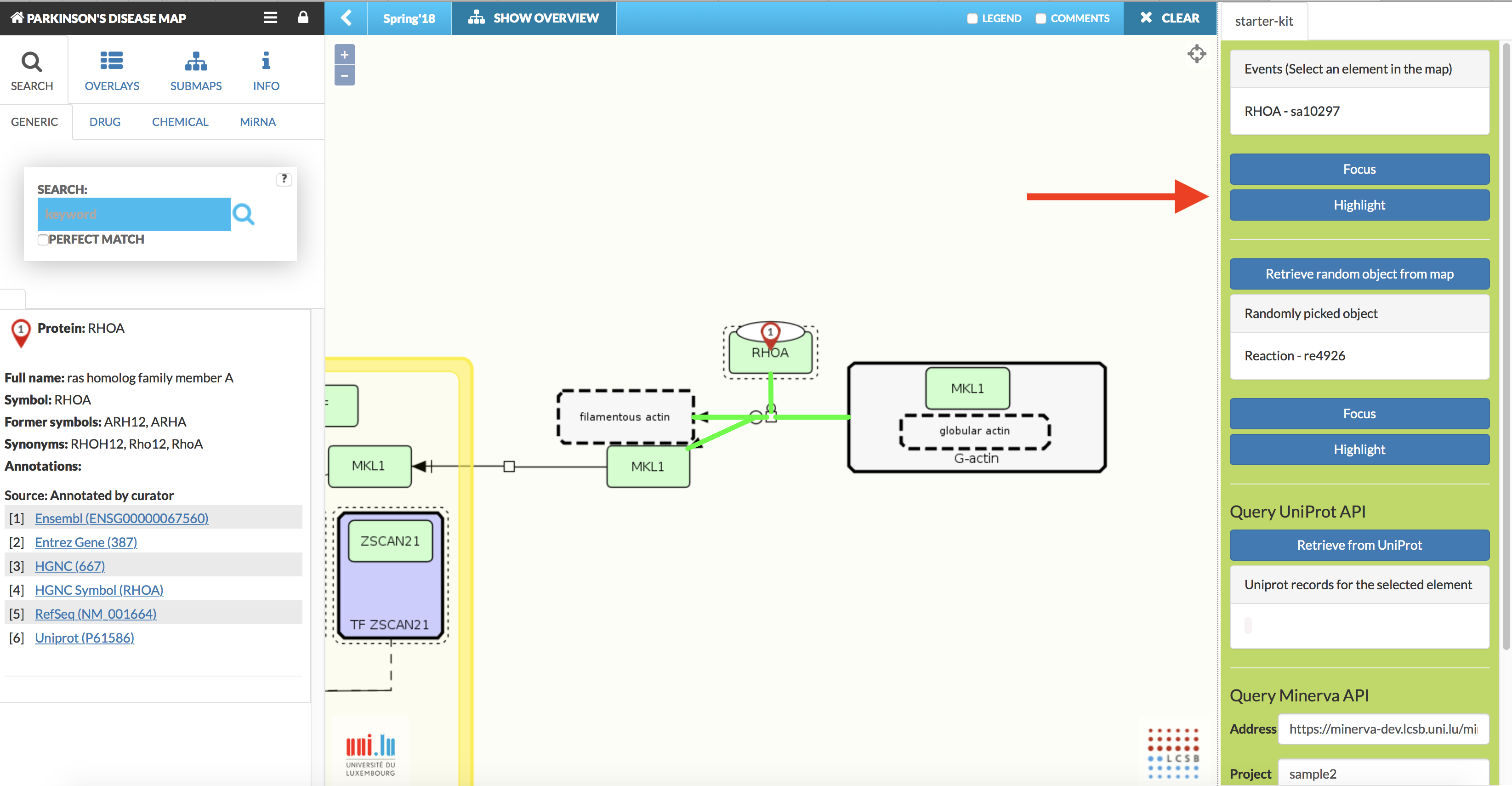 {:width=“900px”}
{:width=“900px”}
Please find below the list of available plugins. Click at the plugin name to find more information about it.
— |
Name of the plugin | Address URL and the short description of the plugin |
Drug reactions | https://minerva-dev.lcsb.uni.lu/plugins/drug-reactions/plugin.js |
| Explore the adverse reactions of the drugs which are interacting with the presented entities in a disease map. |
Exploration | https://minerva-dev.lcsb.uni.lu/plugins/exploration/plugin.js |
| Enhance the visualization and exploration of molecular interaction in the map. |
GSEA | https://minerva-dev.lcsb.uni.lu/plugins/gsea/plugin.js |
| Calculate the enrichment of the elements from the selected overlay in the pathway. |
Variants information | https://minerva-dev.lcsb.uni.lu/plugins/variationinfo/plugin.js |
| Provide the information about the genes variations available in the public resources in the context of a particular disease. |
ADMIN LOGIN#
The options available in the top left corner of the map. The padlock shape icon allows the administrator to login or request an account. To login as user go to Overlays or Info tab.